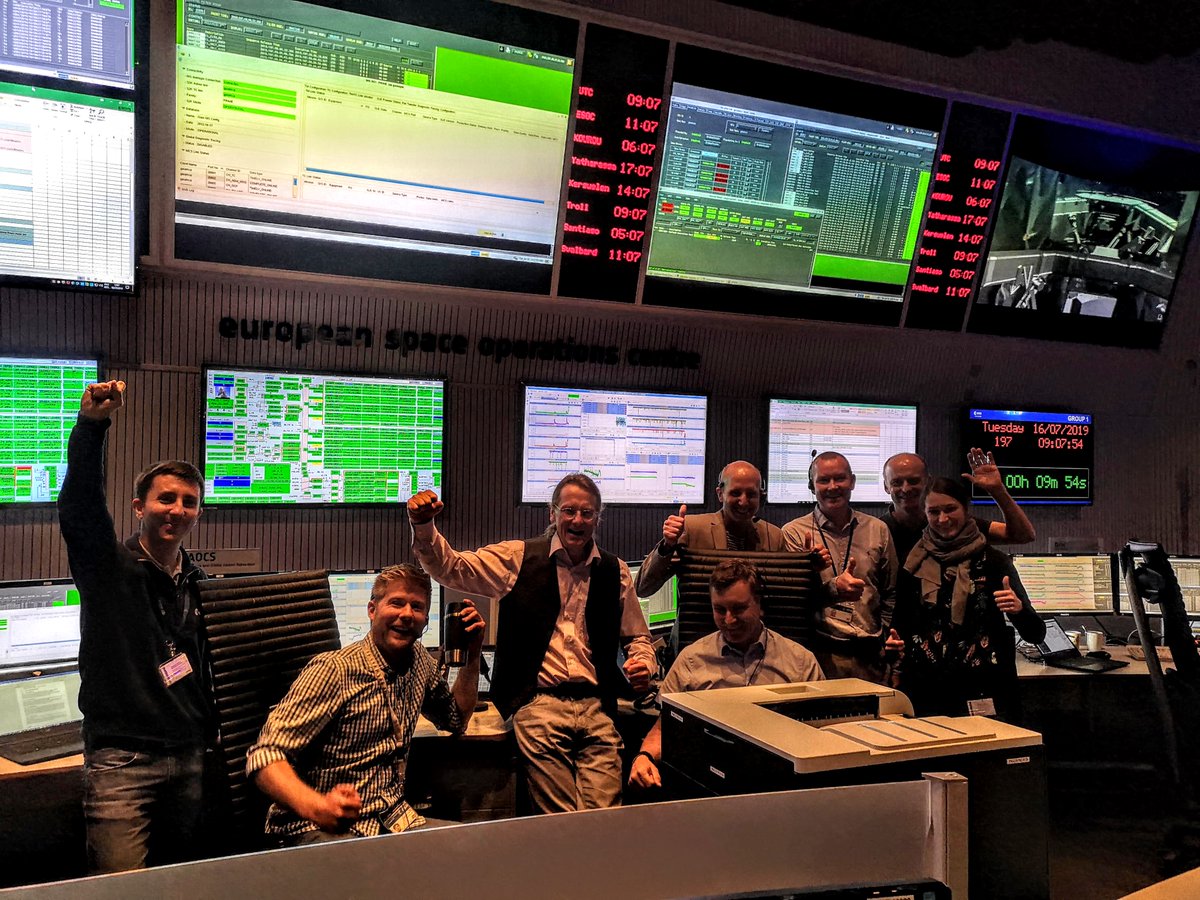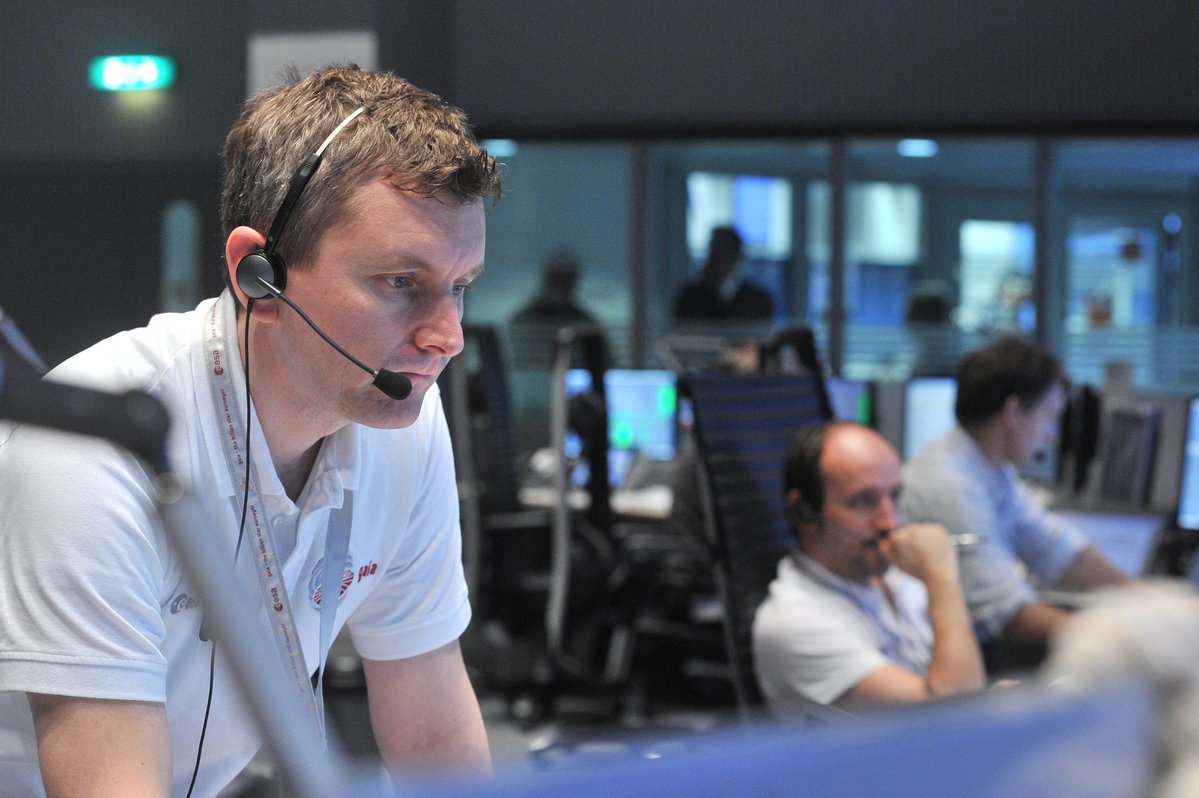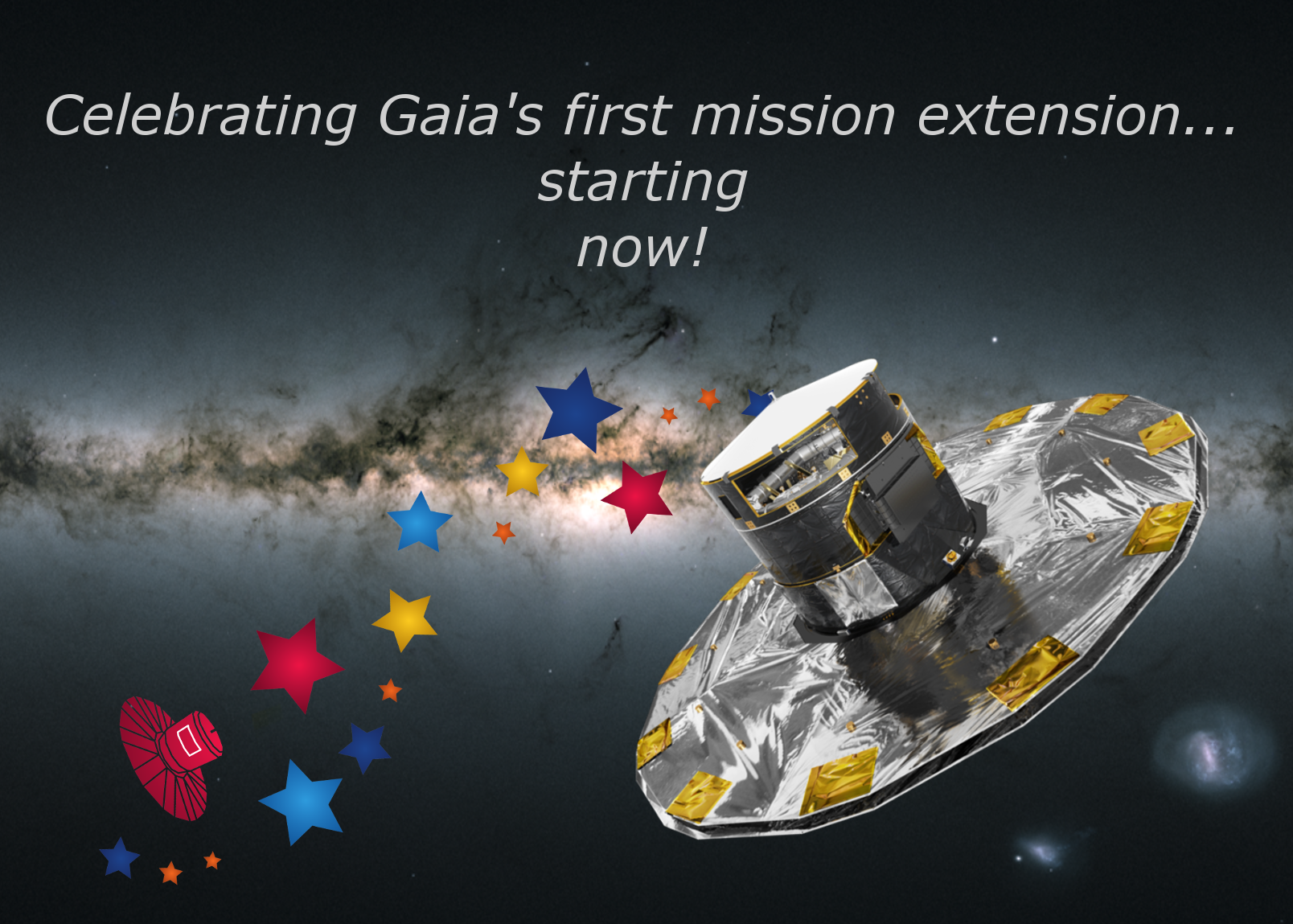IoW_20190717_missionextensionstartsnow - Gaia
Image of the Week |
Whitehead Eclipse Avoidance Manoeuvre marks Gaia's start of mission extension |
|
|
|
Figure 1: Part of the Gaia team at ESOC after succesfully finishing the first manoeuvre leg. Image credit: ESA/ESOC/@esaoperations |
|
Yesterday, Gaia's biggest operation since launch was successfully completed, moving the Gaia mission from its nominal phase into its first mission extension. The Whitehead Eclipse Avoidance Manoeuvre was started yesterday morning by firing the thrusters of the spacecraft through commands sent up to the spacecraft by the Gaia mission flight control team from the ESA mission operations centre ESOC in Darmstadt, Germany.
GAia's orbitThe second Lagrange point - L2 - is a fabulous place to do science. Moving together with Earth about the Sun at about 1.5 million km from Earth, the spacecraft keeps the Sun, Earth, and Moon all in one direction and can thus observe the rest of the sky freely. The region around L2 is a special area where the spacecraft can be maintained at roughly a constant distance from the Earth at the cost of small and infrequent orbit manoeuvres. Gaia's launch to orbit showing its location in space with respect to Sun and Earth. The Earth shadow is visible near the end of the video and the Whitehead Eclipse Avoidance Manoeuvre performed on 16 July 2019 is meant to keep Gaia out of this shadow for the coming years in mission extension. Credits: ESA - C. Carreau / ATG medialab.
Avoiding an Earth eclipseWithout any measures taken to change its orbit, the Gaia space observatory would have moved into the Earth's shadow in August and November this year. During these eclipses, part of the sunlight would be blocked from reaching the solar panels causing Gaia power down. Being in the shade would cause a thermal disturbance as well which would impact the scientific data acquisition for weeks. To avoid ending up in these unfavourable conditions, a manoeuvre was undertaken to change Gaia's orbit in such a way that no new Earth eclipses would be encountered until 2026. Even though Gaia just finished its nominal lifetime, a mission extension was granted. The cold-gas fuel onboard of Gaia, used to keep the spacecraft in a very stable spinning mode for science operations, is expected to keep Gaia spinning till the end of 2024. The Gaia mission extension is expected to improve positions, parallaxes, photometry, and radial velocities by about 40% with respect to the nominal, five-year mission, and improve upon proper motions even more. The mission extension will also have a positive effect on the detection of exoplanets and asteroids as well as on the temporal sampling (window function) of variable stars.
the Whitehead Eclipse Avoidance ManoeuvreThe manoeuvre performed successfully yesterday was called the Whitehead Eclipse Avoidance Manoeuvre to honour Gary Whitehead, who worked fulltime on Gaia since 2007 but sadly passed away last month. Gary was a much valued member of the Gaia Flight Control Team. Before the start of the manoeuvre, Gaia came out of its normal "fine control mode" in which the spacecraft's cold-gas micro-thrusters produce up to 70 microNewtons of force (equivalent to the weight on Earth of a couple of mosquitos). This small force is used to keep the Gaia spacecraft in its very stable spinning mode. After stopping the science data acquisition and the spin down, a series of thruster burns was started. A combination of the onboard chemical thrusters was used for these events, pushing Gaia in a diagonal direction, away from the shadow, in a special technique called 'thrust vectoring'. Gaia has a total of eight chemical thrusters onboard, four designed specifically for moving the observatory in different directions through space, while the other four can also control the atttitude (so the pointing direction). Some thorough advance preparation was needed to get ready for this manoeuvre and the availability of ground stations during the full manoeuvre was ensured. The entire maneouvre lasted a full day, so multiple ground stations have been used to keep in contact with the spacecraft over time, when Earth rotates over the course of the day.
Figure 2: The Main Control Room at ESA/ESOC in Darmstadt, Germany, from which the Gaia Whitehead Eclipse Avoidance Manoeuvre was performed yesterday. Image credit: ESA/ESOC/@esaoperations. Read through some of the tweets from @esaoperations on the thruster burns performed. In between thruster burns, pauses were inserted to allow for the fuel to settle before starting with the next burn.
These nine thruster burns together achieved a total Delta-V of about 14 m/s through the use of about 10 kg of propulsion.
Gaia's extreme sensitivityThe Gaia spacecraft is many times more stable than any other spacecraft in operation today. Maintaining this stability requires certain measures to be taken. Like keeping the spacecraft out of Earth eclipses to maintain its thermal stability. Gaia's payload is operated at a temperature of about -110°C and the sunshield protects against direct illumination of the telescope while the spacecraft rotates around the spin axis at a constant Sun aspect angle of 45°. Gaia's extreme sensitivity allows to see several effects, from small bubbles moving in the Gaia fuel tanks (as seen from tiny wobbles in the attitude while Gaia is in 'fine control mode') to tiny dips in the temperature of the Sunshield corresponding to Sunspots appearing on the Solar surface. A story on Gaia catching a Sunspot can be found here.
Figure 3: David Milligan, Gaia Spacecraft Operations Manager. Image credit: ESA.
Reverse-precession scanning lawFollowing the Whitehead Eclipse Avoidance Manoeuvre, Gaia was spinned up again to start scanning the sky. Instead of returning to what is called the "nominal scanning law", Gaia has been brought into a "reverse-precession scanning law" which will be maintained for 1 year. This "reverse-precession scanning law" has been implemented to break a particular calibration degeneracy in the astrometric data processing which will improve the astrometric solution even further.
A story published by ESA Operations on this manoeuvre can be found here.
We'd like to congratulate the Gaia team at ESOC with their great achievement yesterday and hope to celebrate with you the start of Gaia's first mission extension!
Image credit: Background image: ESA/Gaia/DPAC, Spacecraft image: ESA/ATG medialab.
|
|
Credits: ESA/Gaia/DPAC, ESA Operations, Gaia team at ESOC This story has largely been based on the tweets sent out by ESA Operations from the @esaoperations twitter channel. [Published: 17/07/2019] |
- Removed a total of (15) style text-align:center;
- Removed a total of (5) style text-align:justify;
- Removed a total of (1) border attribute.
- Removed a total of (1) cellpadding attribute.
- Removed a total of (1) cellspacing attribute.
Image of the Week Archive
- Removed a total of (1) border attribute.
- Removed a total of (1) cellpadding attribute.
- Removed a total of (1) cellspacing attribute.








































 Sign in
Sign in
 Science & Technology
Science & Technology



